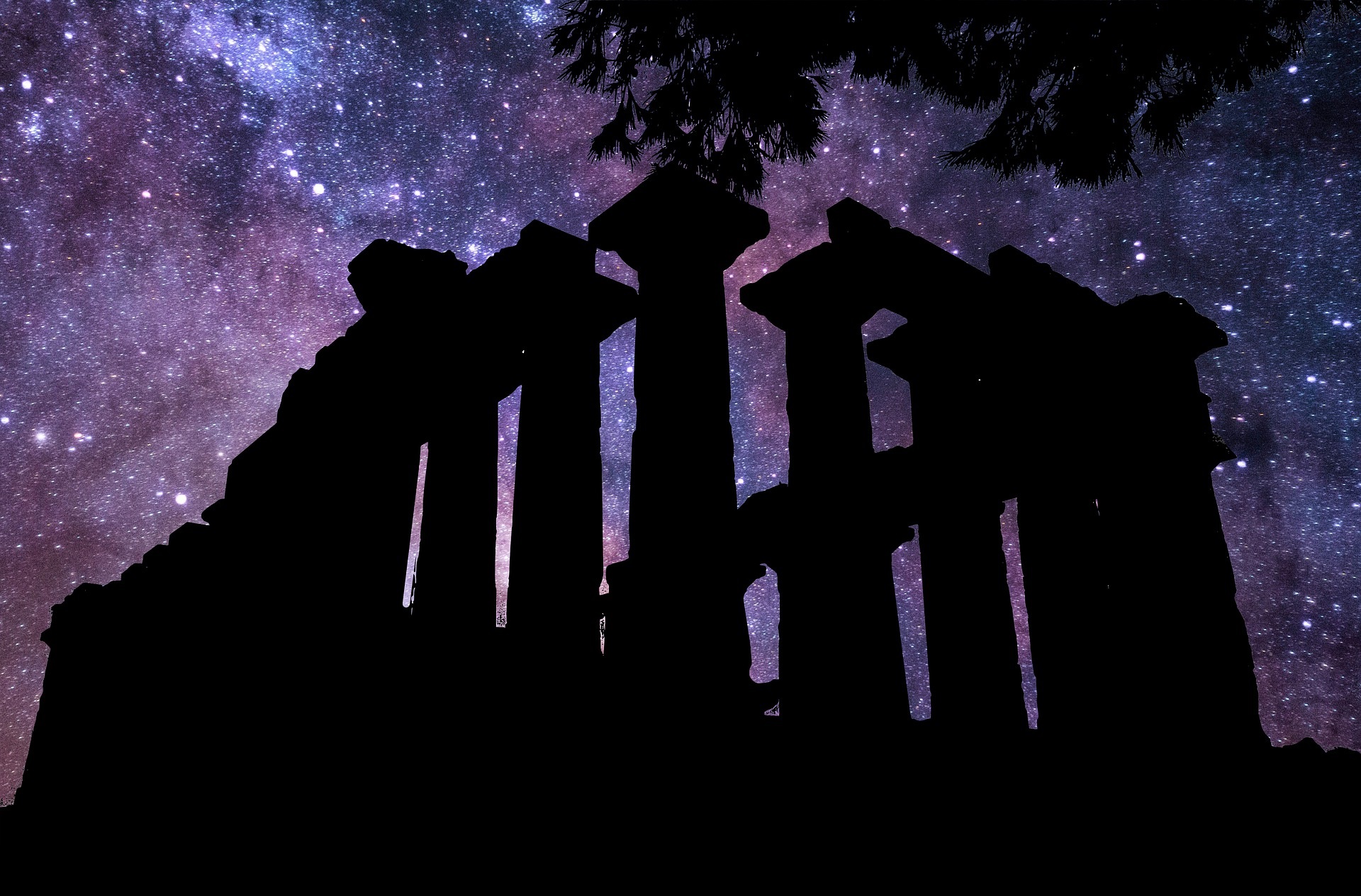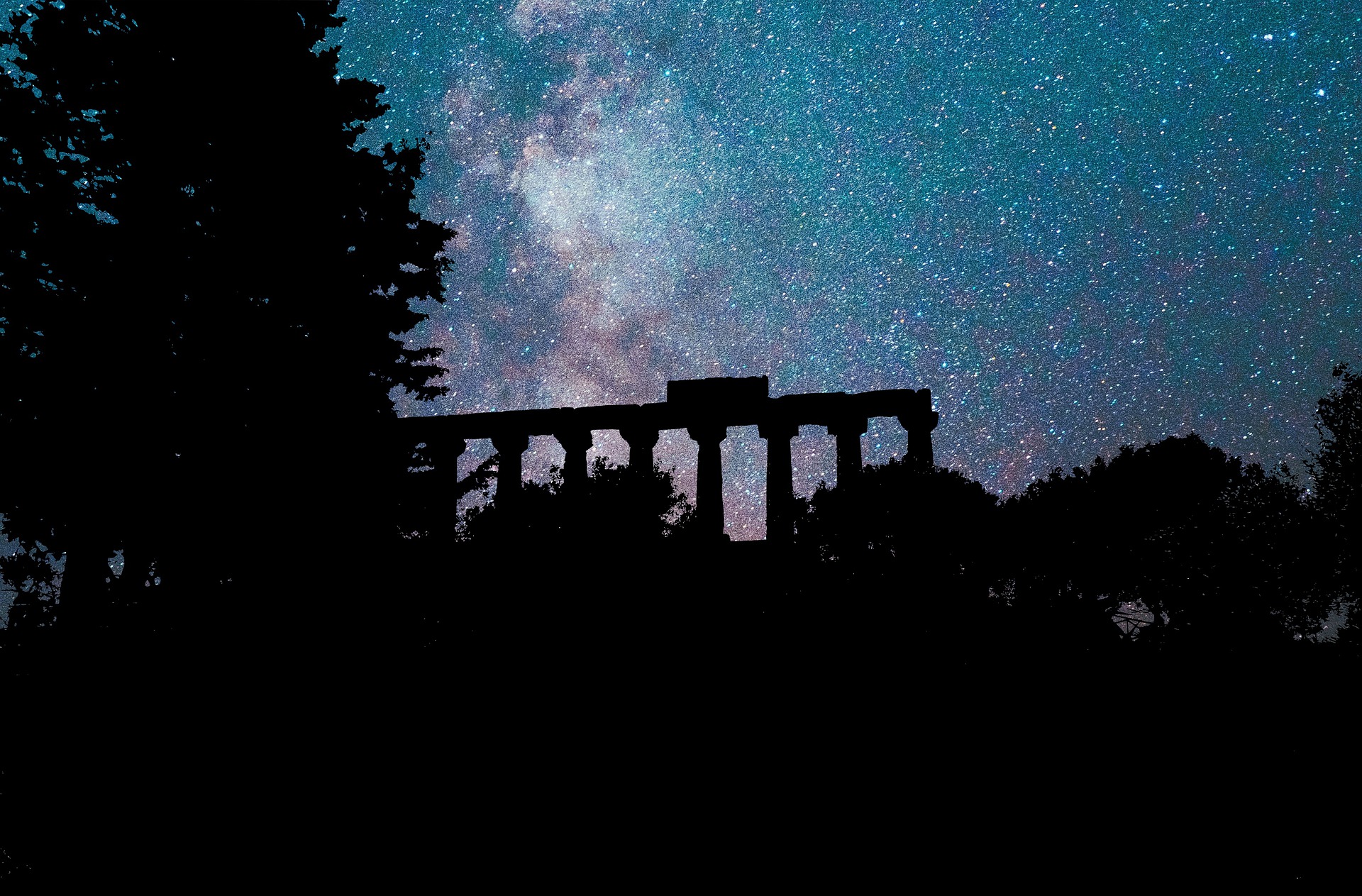Passion of the People – 1.1.6
The Legacy of the Greek and Roman Antiquity
The early Greeks watched the sky very closely. Greek farmers used the positions of the sun and stars to plan and organize agricultural chores for each season. Greek sailors used the stars to guide their navigation. The Greeks’ main contribution to astronomy, however, was their effort to explain what they saw. They did more than merely observe and record the movements of the heavenly bodies. They sought to understand why and how those bodies moved in such an orderly and predictable way. In doing so, the Greeks transformed stargazing into a science.
Greek astronomers spent little time wondering about what the planets were made of or how they came into existence. Instead, they wanted to find a logical, orderly system for predicting the movements of the Sun, Moon, and planets. They looked to mathematics and geometry to help discover such a system. In the 300s B.C., a mathematician named Eudoxus proposed a theory about the movement of the Sun, the Moon, and the planets suggesting that each heavenly body was fastened to the inside of a series of concentric spheres, with the Earth at the center. The spinning of the spheres made the planets move. Eudoxus’s theory failed to explain all celestial movements, however, and other Greek thinkers tackled the problem.
Around 270 B.C., the mathematician and astronomer Aristarchus correctly suggested that the Sun, not the Earth, is at the center of the planetary system. He also suggested that the Earth moves around the sun like the other planets, and that it rotates on an axis. Most ancient thinkers did not believe that the Earth moved, so they rejected Aristarchus’s ideas.
More than a century later, in about 150 B.C., the astronomer Hipparchus developed a theory of celestial movement based on the geometry of circles. He suggested that the sun and the moon moved around the Earth in circular paths, or orbits. To explain why celestial movements are not perfectly regular or symmetrical, Hipparchus theorised that the Earth was not exactly at the center of the orbits, or that the orbits themselves moved in complicated patterns. Hipparchus also compiled a star catalogue that listed 850 stars and gave the location of each in the sky.
The most influential astronomer of the ancient world was Ptolemy. He was born in Egypt in about 90 AD, when the Romans were ruling Egypt. He was a Roman citizen. Ptolemy accepted Hipparchus’s theory and used his own observations to expand it. Ptolemy also produced a star catalogue that listed over 1,000 stars. His view of the Universe was accepted by astronomers throughout the Mediterranean world, and it remained the foundation of astronomy for more than 1,000 years after his death.
One of the best-known manifestations of Roman astronomy is the Julian calendar. It evolved initially from a simple sequence of indigenous festivals related to the farmers’ seasonal year, then became increasingly formalised as Roman society became increasingly urbanised. At first the civic calendar was based on the phase cycles of the moon, but it faced increasingly serious problems in getting out of step with the seasonal year because of political interference in the process of intercalation. All this culminated in 45 BC in the switch from a lunar to a solar calendar, dividing the year into twelve “months” that were in fact completely independent of the Moon.
Astronomy played a significant role in many aspects of Roman life. Land surveyors, employed all over the empire with simple instruments, needed good astronomical knowledge: this is clear from surviving surveyors’ manuals. Other topics instruct the navigators of commercial ships in navigating by the stars. Sundials were in common use for telling the hour of the day: over thirty were recovered in Pompeii alone.
Astrology, popular among the Romans’ Etruscan predecessors as well as in Hellenistic Greece increased greatly in popularity in the second century CE with the rise of mystery cults such as those of Isis and Mithras. These were astral religions, and for many people the Sun itself became an object of direct worship. Later, these cults came into direct conflict with Christianity.


Further Resources
Links below will redirect you to external websites. In accordance with the European data protection declarations, we would like to point out that by clicking on these links you may send data to external providers. We cannot prevent that.
Videos
![]() Astronomy and empire at the Pantheon in Rome (Giulio Magli, Politecnico di Milano)
Astronomy and empire at the Pantheon in Rome (Giulio Magli, Politecnico di Milano)
![]() Legacy of the ancient Greeks (Greek contributions in literature, history, mathematics, medicine, astronomy, and sports)
Legacy of the ancient Greeks (Greek contributions in literature, history, mathematics, medicine, astronomy, and sports)
![]() Agora (a 2009 English-language Spanish historical drama film directed by Alejandro Amenábar about the ancient female astronomer Hypatia)
Agora (a 2009 English-language Spanish historical drama film directed by Alejandro Amenábar about the ancient female astronomer Hypatia)
 Astri in Comune – puntata n. 10 – Religioni astrali e culti misterici dell’antichità – Musei in Comune Roma
Astri in Comune – puntata n. 10 – Religioni astrali e culti misterici dell’antichità – Musei in Comune Roma
 I culti misterici – Iside e le grandi dee madri – Elsa Robert (3/11/2016) – Club di Cultura Classica “Ezio Mancino” APS
I culti misterici – Iside e le grandi dee madri – Elsa Robert (3/11/2016) – Club di Cultura Classica “Ezio Mancino” APS
Online Resources
![]() Blogs about different topics linked to ancient star gazing
Blogs about different topics linked to ancient star gazing
![]() Greek astronomy (Wikipedia)
Greek astronomy (Wikipedia)
 Norbert Froese.(2022) Eudoxos & Co – Die Anfänge der wissenschaftlichen Astronomie
Norbert Froese.(2022) Eudoxos & Co – Die Anfänge der wissenschaftlichen Astronomie
![]() The Remarkable Science of Ancient Astronomy
The Remarkable Science of Ancient Astronomy
 Astrologia in Grecia: la lettura delle stelle – STORICA National Geographic
Astrologia in Grecia: la lettura delle stelle – STORICA National Geographic
 Il cielo greco (I). Età arcaica – ScienzaPerTutti
Il cielo greco (I). Età arcaica – ScienzaPerTutti
 Il cielo greco (II). Età classica – ScienzaPerTutti
Il cielo greco (II). Età classica – ScienzaPerTutti
 Il cielo greco (III). Età ellenistica – ScienzaPerTutti
Il cielo greco (III). Età ellenistica – ScienzaPerTutti
 Il cielo etrusco. Il cielo romano – ScienzaPerTutti
Il cielo etrusco. Il cielo romano – ScienzaPerTutti
 La terra vista dai Greci: teorie e scuole di pensiero – STORICA National Geographic
La terra vista dai Greci: teorie e scuole di pensiero – STORICA National Geographic
 Il prezioso catalogo stellare di Ipparco rispunta in una pergamena medievale – Focus
Il prezioso catalogo stellare di Ipparco rispunta in una pergamena medievale – Focus
 Meridiane e clessidre: ecco i metodi più diffusi per la misurazione del tempo nell’antica Pompei – Made In Pompei
Meridiane e clessidre: ecco i metodi più diffusi per la misurazione del tempo nell’antica Pompei – Made In Pompei
 Il culto di Mitra nell’impero romano – STORICA National Geographic
Il culto di Mitra nell’impero romano – STORICA National Geographic
 Iside: la “grande madre” dell’antico Egitto – STORICA National Geographic
Iside: la “grande madre” dell’antico Egitto – STORICA National Geographic
Further Readings
![]() Inventing the Solar System: Early Greek Scientists Struggle to Explain How the Heavens Move. (Ellen Brundige. Tufts University.)
Inventing the Solar System: Early Greek Scientists Struggle to Explain How the Heavens Move. (Ellen Brundige. Tufts University.)
![]() How the Greeks Used Geometry to Understand the Stars. (Michael Fowler, University of Virginia)
How the Greeks Used Geometry to Understand the Stars. (Michael Fowler, University of Virginia)
![]() Greco-Roman Astronomy and Astrology. (Alexander Jones, The Cambridge History of Science)
Greco-Roman Astronomy and Astrology. (Alexander Jones, The Cambridge History of Science)
![]() Art, Architecture, and Astronomy in the Roman Empire. (Marion Dolan)
Art, Architecture, and Astronomy in the Roman Empire. (Marion Dolan)
 Antike Astronomie. (Heinrich Balss, Hrsg)
Antike Astronomie. (Heinrich Balss, Hrsg)
Teaching Material
![]() Astronomical Discoveries of the Ancient Greeks (Michael Zhang)
Astronomical Discoveries of the Ancient Greeks (Michael Zhang)
![]() Ancient Greek and Roman Astronomy
Ancient Greek and Roman Astronomy
![]() “Teach Astronomy” about the early Roman calendar
“Teach Astronomy” about the early Roman calendar
![]() Teach Astronomy – an astronomy learning tool,
Teach Astronomy – an astronomy learning tool,
![]() Ancient Greek Astronomy for 12 graders / secondary school (Physical Science)
Ancient Greek Astronomy for 12 graders / secondary school (Physical Science)
For Kids
![]() A lecture for kids about planets which were named after Roman gods and goddesses
A lecture for kids about planets which were named after Roman gods and goddesses
![]() Ancient Greek astronomy lessons for Kids
Ancient Greek astronomy lessons for Kids
![]() Greek and Roman astronomy teaching resources. The age of kids can be filtered
Greek and Roman astronomy teaching resources. The age of kids can be filtered
![]() The Zodiac Constellations (Crash Course Kids)
The Zodiac Constellations (Crash Course Kids)
![]() Astronomy, Astrology, and Greek Mythology for Wizards – Harry Potter Inspired
Astronomy, Astrology, and Greek Mythology for Wizards – Harry Potter Inspired
 La meridiana e il fuso orario: che cosa sono? – Focus Junior
La meridiana e il fuso orario: che cosa sono? – Focus Junior
 Misurare il tempo con la meridiana – HUB Scuola
Misurare il tempo con la meridiana – HUB Scuola
